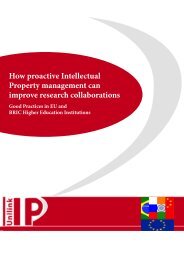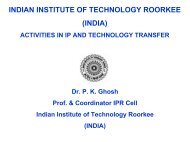Management of intellectual property in publicly-funded research
Management of intellectual property in publicly-funded research
Management of intellectual property in publicly-funded research
- No tags were found...
Create successful ePaper yourself
Turn your PDF publications into a flip-book with our unique Google optimized e-Paper software.
1.4.1. PROs as sources <strong>of</strong> new discoveries - The Open Science ModelAlthough there is a long tradition <strong>of</strong> <strong>in</strong>teraction between <strong>in</strong>dustry and academia as more fullydescribed <strong>in</strong> Chapter 4 below, it can be stated that traditionally, PROs have been recognised as sources<strong>of</strong> <strong>in</strong>novation through two ma<strong>in</strong> routes:- Publications <strong>of</strong> <strong>research</strong> results <strong>in</strong> scientific journals. As soon as published, they enter thepublic doma<strong>in</strong> and can be used by anyone.- Contract work from <strong>in</strong>dustry <strong>in</strong> which PROs have contributed to the development <strong>of</strong> newtechnologies. In most cases, <strong>in</strong>dustry contracts to acquire ownership <strong>of</strong> the results and filespatent applications to protect its development.These are illustrated schematically on the top panel <strong>of</strong> Figure 1.In both cases, no <strong><strong>in</strong>tellectual</strong> <strong>property</strong> rights are reta<strong>in</strong>ed by PROs (other than moral rights l<strong>in</strong>ked tothe authors). We call this model the “Open Science” model because it is comparable <strong>in</strong> many wayswith the open source model <strong>in</strong> s<strong>of</strong>tware development. The only moral obligations from the users are toacknowledge credit to the source and to share the improvements. There is no need to manage<strong><strong>in</strong>tellectual</strong> <strong>property</strong> rights, s<strong>in</strong>ce PROs do not reta<strong>in</strong> them, and there is correspond<strong>in</strong>gly no need fortechnology transfer <strong>of</strong>fices. Innovation is entirely left to the responsibility and diligence <strong>of</strong> private<strong>in</strong>dustry.The Open Science Model is very appeal<strong>in</strong>g to scientists because it accords a universal value to scienceand the unrestricted flow <strong>of</strong> new <strong>in</strong>formation 9 . The quality and reputation <strong>of</strong> <strong>research</strong>ers is measuredby the number and quality <strong>of</strong> peer-reviewed publications. It was the prevail<strong>in</strong>g model <strong>in</strong> the USA untilthe 1980s and still prevails <strong>in</strong> most countries <strong>of</strong> Europe as the traditional basis <strong>of</strong> transferr<strong>in</strong>g PRO<strong>research</strong> results to the public.1.4.2. PROs as Sources <strong>of</strong> New Inventions - The Licens<strong>in</strong>g ModelThe US ExperienceIn the USA, prior to 1980, <strong>in</strong>ventions based on university discoveries <strong>funded</strong> by public moneybelonged to the US government, which had the policy to grant only non-exclusive licenses. In practice,there was little <strong>in</strong>centive on the part <strong>of</strong> <strong>research</strong>ers to file patent applications and little <strong>in</strong>centive on thepart <strong>of</strong> <strong>in</strong>dustry to take non-exclusive licenses from the government.The Bayh-Dole Act 8 strongly encouraged PROs <strong>in</strong> receipt <strong>of</strong> <strong>research</strong> fund<strong>in</strong>g from the FederalGovernment to establish a technology transfer function. The major features <strong>of</strong> the law 9 are:oooTitle to <strong>in</strong>ventions sponsored by the Federal Government are with the university,unless the university chooses not to take title;If the university elects to take title, it must file for patent(s) and show due diligence<strong>in</strong> f<strong>in</strong>d<strong>in</strong>g a licensee that will develop commercial products;The university must share a portion <strong>of</strong> royalty <strong>in</strong>come with the <strong>in</strong>ventor;8 The Bayh-Dole Act. A Guide to the Law and Implement<strong>in</strong>g Regulations” http://www.ucop.edu/ott/bayh.html9 Some <strong>of</strong> these provisions, such as the march-<strong>in</strong> rights and the obligation to manufacture domestically have beenquestioned by both <strong>in</strong>dustry and PROs.8







